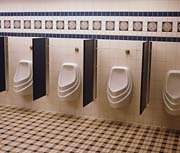
All of the trough-type urinals in the men's restrooms at the Rose Bowl have been replaced by 259 Falcon Waterfree urinals. With the water savings from the Rose Bowl event combined with the savings from UCLA's home football games, concerts, Fourth of July celebrations and other events, the total water conserved in a year from using the waterfree urinals comes to more than one million gallons-a substantial amount for a region where the fresh water supply is struggling to keep up with demand.
Waterfree urinals look like standard urinal fixtures but have no incoming water line and don't use any water. Instead, a replaceable, biodegradable cartridge at the base of the urinal acts as a funnel. Liquid waste passes through the cartridge, penetrating through a lighter-than-water liquid sealant that closes after the urine has passed. Odors are eliminated, since urine is trapped below the sealant and the chemical reaction between water and urine that creates the odor associated with flush urinals is eliminated.
Independent studies in the U.S. and Germany have shown that waterfree urinals are also more sanitary than traditional flush urinals. Because water is eliminated, there is no breeding ground for bacteria. And, since waterfree urinals are touch free, germs are not spread as easily.
Falcon waterfree urinals have also been installed in Miami's Pro Player stadium--site of the 2004 Orange Bowl. The total water savings estimated from these two bowl games was more than 237,000 gallons.
Waterfree urinals have been installed in many locations around the world since the mid-1990s. Other well-known installations include the San Diego Zoo, London's Heathrow Airport, and the University of North Carolina. More information regarding waterfree urinals is available at www.falconwaterfree.com.